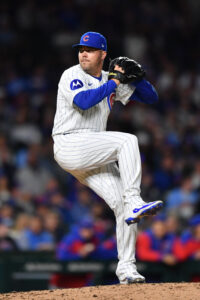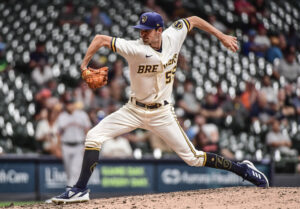TODAY: Both The Athletic’s Patrick Mooney and USA Today’s Bob Nightengale expanded on Feinsand’s link between Gallen and the Cubs, writing that Chicago indeed has interest in the free agent. Giving up draft compensation to sign Gallen isn’t a deal-breaker for the team, Mooney notes, as the Cubs have shown interest in other players (i.e. Ranger Suarez, Michael King) who rejected qualifying offers.
DECEMBER 5: Right-hander Zac Gallen didn’t have the platform season he envisioned heading into free agency, but the former Cy Young finalist and All-Star nevertheless turned down a qualifying offer from the D-backs and hit the open market last month. Susan Slusser of the San Francisco Chronicle reports that the Giants have had conversations with Gallen’s camp (video link). MLB.com’s Mark Feinsand adds the Angels and Tigers to the list of teams with interest in Gallen. He also indicates that the Orioles, Cubs and Braves have at least looked into Gallen. Meanwhile, John Gambadoro of 98.7 Arizona Sports recently suggested a D-backs reunion was unlikely.
Gallen, who turned 30 in August, struggled through four brutal months to begin the 2025 season but ended with a flourish. Through the time of the trade deadline, the right-hander was lugging a 5.60 ERA toward the finish line. That ugly ERA came despite roughly average strikeout and walk rates (22.1% and 8.6%, respectively). He was getting hammered by the long ball, yielding 23 homers in his first 127 frames of the season (1.63 HR/9).
From August onward, Gallen looked more like his typical self. His strikeout rate dipped two percentage points, to a below-average 20.3%, but his walk rate improved to 7.1%. Most importantly, he cut back on the home runs. Gallen yielded just eight round-trippers in his final 65 innings — a rate of 1.11 per nine innings, which falls far more closely in line with his career mark (1.05).
Even with a 3.32 earned run average over his final 11 starts, Gallen closed out the year with an unsightly 4.83 ERA overall. It’s not a strong mark, but Gallen and Boras are surely hoping that track record and impeccable durability will carry his market. Gallen started 33 games in 2025 and is tied with Jose Berrios for the fourth-most starts in MLB (126) dating back to 2022. His 734 innings rank third in the sport during that time, trailing only Logan Webb and Framber Valdez. Gallen has only been on the major league injured list three times in his career — a pair of short stints due to hamstring strains in 2024 and 2021 and a month-long IL stay for a mild elbow sprain back in ’21.
The Giants are a sensible fit. They’re looking for rotation help but not keen on handing out the type of six- and seven-year deals we’ll see for many of the market’s top names. Giants brass has seen him more than most pitchers over the years, as an ultra-durable stalwart in a division rival’s rotation. President of baseball operations Buster Posey even personally faced Gallen eight times, going 2-for-6 with a pair of walks and a home run.
San Francisco has the aforementioned Webb atop the rotation and signed through 2028. No. 2 starter Robbie Ray is signed only through the 2026 season. Right-hander Landen Roupp positioned himself for a rotation spot with a nice showing through 22 starts in his age-26 season. Other candidates at the moment include Hayden Birdsong, Carson Whisenhunt, Blade Tidwell, Kai-Wei Teng, Trevor McDonald and Carson Seymour. It’s a fine collection of depth, but there’s also plenty of uncertainty (hence the focus on rotation upgrades).
Gallen wouldn’t need to be the Giants’ ace but would give them a reliable source of innings and a big track record on which to dream. The Giants’ projected payroll, per RosterResource, is a bit under $169MM. That’s right about the same level at which they opened the 2025 season, but Giants ownership has topped $200MM payrolls in the past — even as recently as 2024. There’s room to add to the budget.
The Angels’ projected payroll is in a near-identical spot to that of the Giants, but the Angels trotted out a $203MM Opening Day mark just this past season. Mike Trout and Yusei Kikuchi are the only players signed beyond the 2026 season, and only Trout is signed beyond 2027.
In Anaheim, Gallen would join a rotation currently fronted by Kikuchi and Jose Soriano. Beyond that duo, the Angels are likely to give former top prospect Reid Detmers, who had a strong season in the bullpen in ’25, another look in the rotation next season. They’ve also acquired Grayson Rodriguez from the Orioles and signed Alek Manoah to a one-year deal this winter. Former top prospect Caden Dana headlines the depth options — a group also including Mitch Farris, Sam Aldegheri, Walbert Urena, Jack Kochanowicz and prospect George Klassen, who has not yet been added to the 40-man roster. There are some talented arms in the mix, but as with the Giants, the Halos simply lack stability behind a pair of generally established veterans atop the rotation.
Over in Detroit, the Tigers have some more stability but less depth. Having the best pitcher on the planet on the roster is a nice start, of course, and the Tigers can follow Tarik Skubal with Jack Flaherty, Casey Mize, Reese Olson and sophomore Troy Melton. Adding Gallen would push Melton to the top depth option, presumably in Triple-A, alongside Keider Montero, Sawyer Gipson-Long, Ty Madden and prospect Jaden Hamm (not yet on the 40-man roster).
The Tigers have one of the cleanest long-term payroll sheets of any club in MLB. Javier Baez’s six-year contract runs through 2027. He and Colt Keith — playing on a six-year, $28.6425MM extension — are the only two players guaranteed anything beyond the 2026 season. Adding Gallen would give the Tigers some 2026 stability and protect them in the event that Skubal, Flaherty and/or Mize all depart in free agency next winter.
The other clubs listed by Feinsand are all known to be in the market for rotation help, too, so none of the bunch is particularly surprising. It’d be out of character for the Braves to sign Gallen, unless his market collapses and he signs a short-term pillow deal (either one year or two years with an opt-out). Atlanta hasn’t given more than $30MM to a free agent starting pitcher under president of baseball operations Alex Anthopoulos. The Orioles are likely searching for ceiling over stability, so unless they’re confident they can get Gallen back to his 2022-23 form, he’s probably not Plan A or B in Baltimore. The Cubs are already counting on one bounceback from a notable starter (Shota Imanaga), though Gallen fits the spending profile they’ve pursued in offseasons more than the other names at the top of the market.
Even coming off a down year, Gallen will likely find a multi-year pact. Even if he prefers to bet on himself with a shorter-term deal, he’s precisely the type of former All-Star for whom the Boras Corporation has frequently negotiated two-year deals with opt-out pacts. We predicted a four-year deal for Gallen on our annual ranking of the sport’s Top 50 free agents, believing that the market will value his durability and track record enough to get him paid nicely — albeit not to the extent he’d have enjoyed coming off a more typical season. Gallen will presumably be presented a variety of contract structures, many of which will have opt-out opportunities or convoluted multi-year player and club options alike. The deal he ultimately accepts will hinge on his personal level of risk aversion.
]]>

